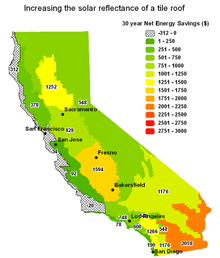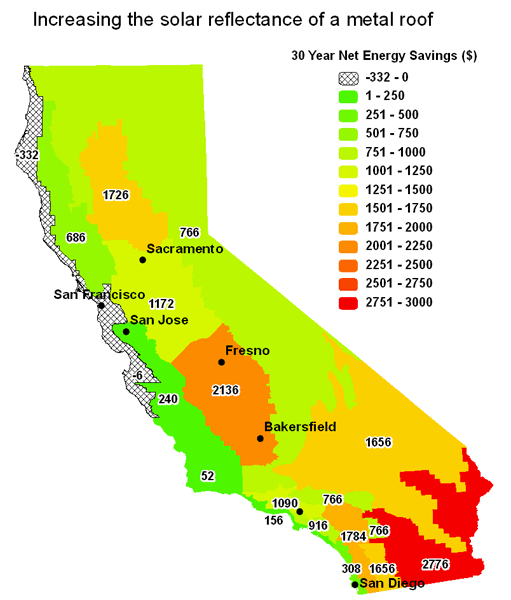Reduce Your Cooling Energy Bill
Substituting cool roofing material for traditional dark roofing material lowers the daytime surface temperature of the roof, which in turn reduces the flow of heat into your living space. By reducing the heat in your home you reduce the load on your air conditioner in the summer, saving electricity and keeping more of your money in your pocket.
 |
 |
 |
These three images display the present value energy cost savings for a 2000 square foot tile, asphalt shingle and metal roof assuming that each roof will have a 30 year service life. The hatch mark shows the climate zones where there is not an energy cost saving while the reds and oranges show the greatest savings.
Image source: LBNL – Heat Island Group
Note: Choosing a cool roof instead of a standard roof can slightly increase the need for heating energy in winter. However, these winter penalties are often much smaller than summer savings even in cold climates because the northern mainland U.S. (latitude # 40°N) receives about 3 to 5 times as much daily sunlight in summer as in winter.
Reduce Energy Use
A cool roof transfers less heat to your living space below, so your house stays cooler and more comfortable, requiring less energy for cooling. The energy savings of a cool roof may vary depending on the local climate and the design of the building. The table here shows examples of cooling energy savings from different buildings with cool roofs.
| Location | Size (ft2) | Roof Insulation* | Roof Space | Annual Cooling Savings | Peak Demand Savings |
|
Sacramento, CA |
1,825 | R-11 | None | 69% | 32% |
|
Merritt Island, FL |
1,800 | R-25 | Attic | 10% | 23% |
|
Cocoa Beach, FL |
1,795 | R-11 | Attic | 25% | 28% |
|
Nobleton, FL |
900 | R-3 | Attic | 25% | 30% |
|
Cocoa Beach, FL |
1,809 | None | Attic | 43% | 38% |
*Note: These insulation levels are lower than the energy efficiency levels recommended by ENERGY STAR. If insulation levels were higher, the cooling savings likely would be less. Citation: U.S. Environmental Protection Agency- Reducing Urban Heat Islands: Compendium of Strategies — Cool Roofs
Reduce Peak Electrical Demands
Another benefit of cool roofing is that it saves energy during peak electrical demand periods, which generally occur on hot summer afternoons. Reducing peak electrical demand during summer time can reduce the strain on the electrical grid and therefore lessens the likelihood of brownouts and blackouts. The more buildings have cool roofs, the more our entire community benefits.
Downsize Your Air Conditioning Unit
When your home is cooler, it gives your air conditioner a break. When your AC unit doesn’t have to work as hard to cool the home, you can even install a smaller, less expensive unit. Smaller air conditioners are also typically less expensive to run, because air conditioners are more efficient near full load than at part load.
Extend the Life of Your Roof
Lowering the peak daytime temperature of soft roofing products, such as single-ply membranes and asphalt shingles, may help them last longer. A cool roof may last longer because it doesn’t shrink and expand as much as traditional soft roofing products throughout the day. Reducing the stress on the roof can make the materials last longer.
